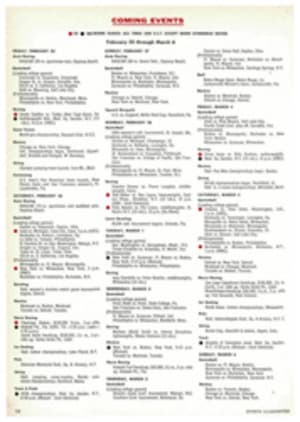
THE MIDGET MARVELS
There's a legend, apparently apocryphal, that if you cast a coin over your left shoulder into the burbling water of the beautiful Trevi Fountain in Rome your wish will come true. You can try it in the Exhibition Hall at Madison Square Garden, New York City, where the Universal Travel & Auto Sports Show, under the direction of Fred Pittera, has opened its doors. The Trevi Fountain is a convincing papier m√¢ché replica of the Roman original and the appeal to cast coins in its waters is in a worthy cause—the fight against cerebral palsy. And there's a lot in the show to wish for.
By and large I found it an interesting exhibition, aimed less at the sports car aficionado (who already has seen most of the 1955 Jaguars, Ferraris, Maseratis and the rest) than at the general public, with emphasis on the bizarre, the super-luxurious or the refreshingly new. On the top rungs of the price ladder, three custom built machines lorded it over the other exhibits. First was a Chrysler Imperial sports sedan with an aluminum body 22 feet long and brightwork in genuine 24 carat gold instead of plebeian chrome. Equipped with a souped-up, 300 hp V8 engine which can push it along at 130 mph, this car doubtless inspired the new Chrysler "300," and about $25,000 would put you at its wheel. Not far behind (at $20,000 or so) was an imposing British Bentley sedan with streamlined bronze coachwork by Bertone of Italy, featuring every conceivable push-button luxury. And in third spot, a strikingly crafted Cadillac chassis with a German-built Spohn body styled by Brooks Stevens of Milwaukee, Wis. This splendiferous machine, romantically named the "Valkyrie" and finished in black and white for startling contrast, is to be built in limited numbers by the Imprex Company of Cleveland, Ohio; $15,000 is the tag.
THE SMALL AND THE SMALLEST
At the other end of the scale was the most versatile and intriguing selection of three-wheelers and scooters yet seen at an American show. In the three-wheeled group, German plane-builder Messerschmitt has come up with a lulu—a miniature, tandem-seated, bug-eyed job with a hinged plexiglass top. Powered by a 9-hp, single-cylinder, air-cooled engine, it weighs 485 pounds, runs 100 miles on a gallon of gas and will do 50 mph. You can own it for only $895, f.o.b. New York, and its uses in the suburban scheme of life are countless—meeting commuter trains, doing your local shopping, taking the kids to school, visiting friends and so on. Larger, more powerful, but still on three wheels is the nimble Tri-Car Suburbanette. Looking like a truncated sedan, the Tri-Car has a Fibre-plastic body and a rear-mounted Lycoming two-cylinder air-cooled engine. It features an automatic transmission and torsilastic (live rubber and metal) suspension independent on all three wheels. The Tri-Car will hit 60 mph from a standstill in 16 seconds, top 40 miles on a gallon, despite its 30 hp, and climb 22% grades. It carries two in comfort and—like the other three-wheelers—costs under $1,000.
Among the scooters the Milan-built Italian Lambretta is a joyous little 6-hp machine with miniature tires (4.00 x 8) and an air-cooled engine. It will carry two people on tandem saddles (or three with an American-built lightweight sidecar) for 125 miles on a gallon of gas and still top 50 mph. The Lambretta, which is built by the Innocenti Corporation, first appeared in 1946 when that firm reconverted from war contracts. It has since found 750,000 buyers in Europe, mainly Italy, and is now being produced at the rate of 1,000 units a day. U.S. delivered price is only $329, or $428 with sidecar, and the Lambretta will take you anywhere—even over mountains. In fact, Union Tours are promoting a round-trip, $1,425 packaged European vacation starting from New York, which includes the price of a Lambretta scooter delivered in Milan.
100 MPH ON ONE-THIRD THROTTLE
From a performance standpoint, the outstanding exhibit of the show was a metallic-gray Bertone-bodied sports job on an Alfa Romeo 1900 chassis with a 100 hp engine. Called the BAT-5, this experimental machine is so efficiently streamlined that it can hold 100 mph on 46% of its power with the throttle only one third open. Maximum speed is 123 mph and the BAT can be driven "hands-off" at 50 mph.
But for all the show's galaxy of four-wheeled performers totaling probably 15,000 hp and more than a million dollars, it's the little fellows that stand out; and among them, the saucy Italian Isetta is the most intriguing. Looking like a fighter plane cockpit on four wheels, it is powered by a two-cylinder, air-cooled engine of 10 hp that runs better than 70 mpg. Top speed is 60 mph and when you get to where you're going, you open the front door and just step out—the wheel and steering column are hinged to swing out of your way.
PHOTO
AMERICA'S TRI-CAR
PHOTO
BENTLEY AND MESSERSCHMITT
PHOTO
ITALY'S ISETTA

